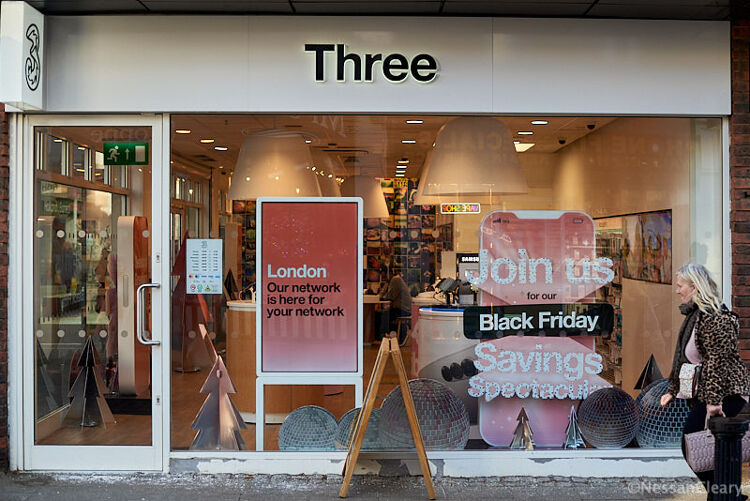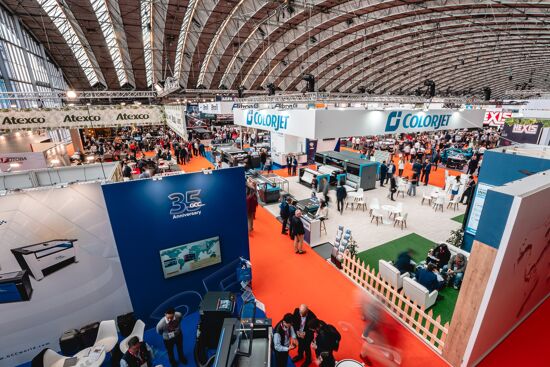Are digital screens for interior displays a challenge for printers?

Nessan Cleary discusses how the increased popularity of using digital screens for interior displays may pose a challenge for printers. Nessan states there are numerous sustainable options for prints designed for interior spaces.
We are all used to seeing a range of different types of signage in interior settings, from way finding and information through to advertising. Over the last ten years or so this mix has started to include digital screens and the use of such screens has accelerated rapidly since the pandemic. Some might see this as a challenge to printed graphics but it also represents a new opportunity for diversification.
There are a number of advantages to using digital screens. The screens are inherently bright and naturally attract attention, one of the main challenges for any kind of display advertising. They can include video and animations, and can cycle through several messages, which can keep viewers engaged. The fact that the messages can be constantly changed means that the space can be sold many times over, depending on the time each message is displayed.
The messages can be easily changed without having to send out a crew to take down and put up printed signs. Consequently, digital signs are ideal for very short run marketing campaigns or flash sales. And because the messages can be quickly updated, the advertising can be changed to match the prevailing circumstances, such as weather conditions or the result in a sporting event. Equally, the messaging can change throughout the day, perhaps advertising coffee shops in the morning and then switching to restaurants later in the day.
In many indoor settings, the digital screens fulfill a further role such as helping shoppers navigate around a retail centre, to providing traffic updates at a motorway service station. Some fast food outlets have already started using interactive screens to display menus and allow customers to order their food directly from the screens, complete with an NFC payment module for bank cards and mobile phones.
There are two fundamental parts to a digital screen set-up. The first is obviously the screen itself, complete with its casing. The pricing of screens has come down a lot in recent years. Nonetheless, the screen will need to have high enough resolution for close up viewing and to be bright enough to cope with the ambient light conditions in its intended location.
The other half is the content management system, which drives the media player. For single screens the content can be run from a USB stick. But for many indoor settings, such as a shopping centre or a department store, where there might be multiple screens in use, it makes sense to have a fully networked closed loop system giving a singe point of control for all the screens.
 Large screens themselves can make a statement. ©Nessan Cleary
Large screens themselves can make a statement. ©Nessan Cleary
The main drawback to a multi-screen set up is the high cost to install it, particularly in larger venues with lots of screens. There will be ongoing costs in maintenance and of course for the power to run the system. There will also be further costs in having to replace screens from time to time.
However, there are also several freestanding solutions available that allow companies to test out the effectiveness of using a small number of digital screens without having to spend large sums. The simplest is a secure tablet stand that can hold a tablet at a conventional height, using the tablet’s own battery power and networking capability for an effective interactive display that can easily be deployed where needed. There are also larger freestanding kiosks that can incorporate other features such as a dispenser for hand sanitizer or a brochure holder that can be used anywhere from an exhibition stand to a department store. These units usually draw their content from a USB stick so that they only require a standard mains electricity plug to run. There are also larger totem stands with screens typically around 55ins that run off an Android OS so that they can be connected via WiFi and can draw content from the internet. Such stands can even incorporate speakers to support video content or play music.
Print and interactivity
Touchscreens are inherently more interactive than other displays but can only by used by one person at a time. Using a QR code can give a degree of interactivity to any printed display, even down to ordering products since many people now use payment systems on their mobile phones.
There are other advantages to printed displays that shouldn’t be overlooked. They are relatively cheap and can have a long life, particularly in indoor settings. Installation is usually easy in many interior settings as the frames are permanently in position so that it’s just a matter of replacing one printed sheet for another.
And of course, print is not limited to display graphics but can also include floor graphics to lead visitors around an interior space, as well as wall coverings that can create an immersive experience. Printed fabrics can greatly add to this, with for example, soft furnishings in a cafe or drapes to separate different areas and create a softer experience in a retail setting.
Another consideration is the overall sustainability, which will vary from one location to the next. It can be argued that digital signage is more sustainable because there is no printed material to remove and dispose of once the marketing campaign is finished. However, running a network of screens will have its own energy footprint so its overall sustainability will really depend on how this energy is generated. In addition, the displays themselves will have to be replaced every few years, either through wear and tear or simply to upgrade the display quality, which will need some care to recycle properly. This is likely to become an increasing concern as more regulation is introduced to reduce the level of e-waste that developed nations now produce.
There are plenty of sustainable options for prints destined for interior spaces, many which you can find at Fespa’s own exhibitions. This ranges from a choice of substrates, including textiles and paper-based boards, through to the use of water-based inks. There’s usually very little need to laminate prints for interior use and no justifiable requirement to use weather-resistant plastics so that print can offer a highly sustainable option.
Nonetheless, the final analysis is going to come down to cost versus reward. For many spaces that’s going to result in a mix of digital screens in areas of high footfall backed up by different printed options.
To discover the latest content that covers a wide range of sectors including digital signage and interior decor sign up for FESPA’s free monthly newsletter FESPA World available in English, Spanish and German.
Interested in joining our community?
Enquire today about joining your local FESPA Association or FESPA Direct
Recent news

GenAI + POD: The Smartest Way to Add Personalised Products to Your Retail Offering in 2025
In 2025, GenAI and POD are transforming retail. Masterpiece AI empowers businesses to offer unique, AI-generated personalised products, from apparel to home decor. Customers use text prompts to create custom designs, streamlining production and boosting sales. This revolutionises customer experience and product offerings.
.png?width=550)
What qualities should visionaries in print have? With Folker Stachetzki from Brother
We speak to Folker Stachetzki, Head of Marketing at Brother about visionaries in print.

Bolstering personalisation by combining print and digital technology
Using printed material in combination with digital technologies offers more opportunities to those offering personalisation to customers. Rob Fletcher shares some recent examples of the print and digital working together to enhance the impact of personalised pieces.

European Sign Expo to highlight developments shaping the future of signage and visual communications
European Sign Expo 2025 (6 – 9 May, Messe Berlin, Germany) is weeks away and a host of leading exhibitors are all set to welcome Visionaries from across the signage and visual communications industries to their stands.